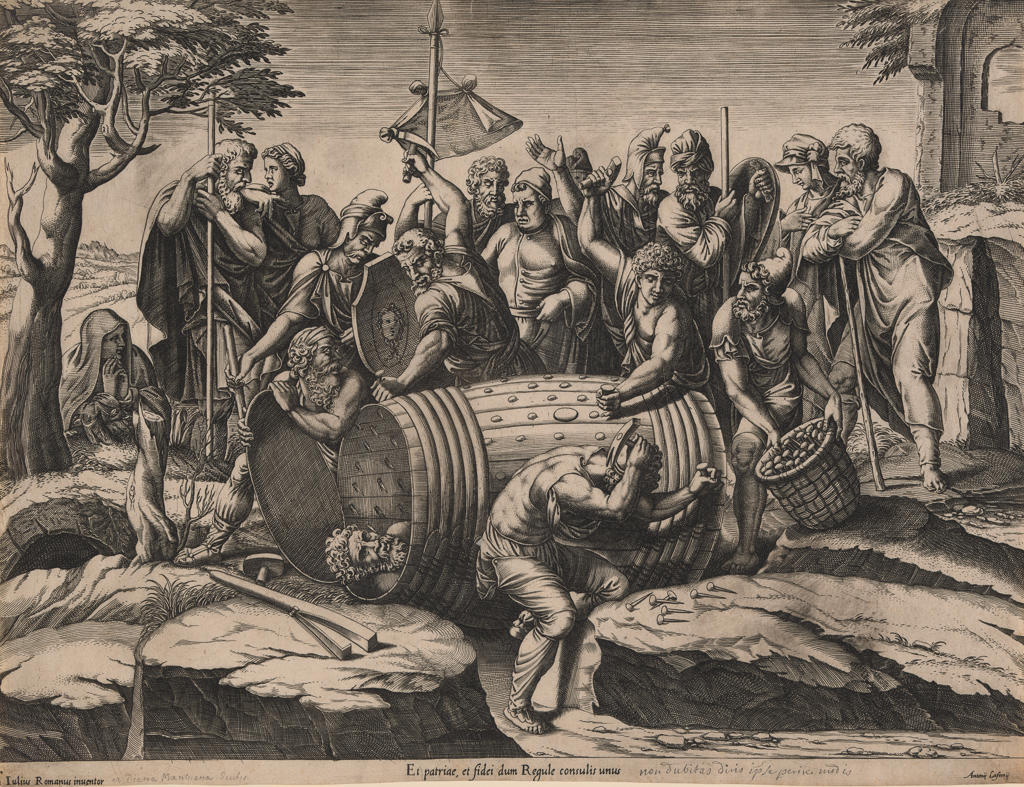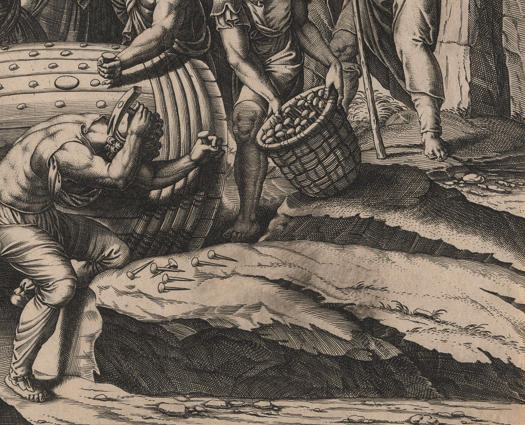An engraving recently acquired by the Museum is a work by one of the few female engravers of the Italian Renaissance, Diana Mantuana (ca. 1547–1612), also known as Diana Scultori and, erroneously, Diana Ghisi. This shocking print depicts a moment of cruel anticipation, when the heroic Roman consul, Marcus Atilius Regulus, is about to be rolled down a hill within a nail-studded barrel by an angry mob. Regulus is already captive within the barrel as a man pound nails into the side, aided by another with a full basket of nails and a third at the ready to close the lid. Around the barrel a group of men and women dressed in military and classical costumes watch the action with intent gazes and theatrical gestures. A raised flag indicates a sanctioned event, one that no one in the image attempts to prevent. Polybius (2nd century BCE), and Horace (1st century BCE) both relayed the story of Regulus, telling us that his torturers were the Carthaginians, who captured Regulus during the First Punic War (3rd century BCE). After his capture, the Carthaginians sent Regulus on a forced embassy to the Roman Senate to plead for negotiations favorable to Carthage. In Rome, Regulus refused to alter his loyalty, and then returned to Carthage because he had given his word to do so, despite certain death (Wallace, 395).
The Latin verses below the print (which have been cut from the Museum’s impression) give some guidance for its interpretation:
Et patriae, et fidei dum Regule consulis unus/Non dubitas diris ipse perire modis (While you alone take thought for your fatherland and your honesty, Regulus, you do not hesitate to die in a horrible manner). (translated by Wallace, 296)
Emphasized here is Regulus’s honesty, faithfulness, and willing self-sacrifice, which is reinforced by the placid look on his face even as he is about to die a painful death. Regulus was held up as the embodiment of noble and civic virtue by the ancient writers, including the Roman orator Cicero, who heralded the consul as an example of fearlessness, tranquility, dignity, and honor. These qualities aligned with Stoic philosophy, which emphasized self-control of emotions and human actions, over words, as the best indicator of individual virtue. (Wallace, 395–96) When Diana Mantuana made the engraving during the Renaissance, Stoicism, like other classical philosophies, was in the midst of an important revival in Europe.
The engraving by Diana—the single name by which she signed many of her copperplates (Lincoln, 1102–03) — is a reproductive engraving after the composition of Giulio Romano (1492/1499–1546), the celebrated pupil of Raphael and the artist to the Duke Federico Gonzaga of Mantua in the second quarter of the 16th century. From about 1525 to 1535, Romano and a host of assistants decorated the Duke’s country estate, the Palazzo del Te, with mythological, historical, and allegorical subject matter. The Appartamento del Giardino Segreto (Apartment of the Secret Garden) was the duke’s private study, decorated in fresco with episodes from ancient history, including the Atilius Regulus story.
It was from this composition that Diana made her print, crediting Romano for the invention by inscribing Julius Romanus inuentor (Giulio Romano inventor) in the plate at the lower left of the composition. According to Cicero, Regulus was bound to a machine and his eyelids cut off, thus dying from lack of sleep. The manner of death in Romano’s composition (and thus Diana’s) differs from Cicero’s account, and it is possible that the boundlessly inventive Romano conceived of the idea for the diabolical nail-studded barrel himself (Wallace, 396).
Diana Mantuana was raised at the Mantuan court, the daughter of the artist Giovanni Battista Mantovano, also called Scultori (1503–1575), who was employed as a court sculptor and engraver at the same time as Giulio Romano. Female artists were scarce in the Renaissance, female printmakers even more so, given the public nature of the art (Lincoln, 1110). Diana’s exposure to printmaking was due to her father’s profession as an artist and undoubtedly his willingness to train her in the craft of engraving. The Italian artist and biographer Giorgio Vasari described meeting the artisan family with some admiration on a trip to Mantua in 1566 when Diana was 19. He wrote in his journal:
All in all, from what I saw last time I was in Mantua to this year, 1566, when I returned, the city is so much more ornamented and more beautiful that, if I had not seen it, I would not have believed it. What is more, the number of artisans has multiplied and keeps on multiplying. Inasmuch as this, to Giovanni Battista Mantovano (engraver of prints and excellent sculptor, whose story I related in the Lives of Giulio Romano and Marcantonio Bolognese) there were born two sons who engrave copper plates divinely, and what is more marvelous, a daughter named Diana also engraves so well that it is a wonderful thing: and when I saw her, a very well-bred and charming young lady, and her works, which are most beautiful, I was stunned. (Vasari, 6:490, quoted in Lincoln, 1105)
The sons mentioned were Adamo Scultori (ca. 1530–1585) and another artist, Giorgio Ghisi (1520–1582)— erroneously identified as a son by Vasari—, the latter who would become one of the most innovative engravers of his time (Lincoln, 1105). Mantua presented a vibrant atmosphere from which to learn the art of engraving, with the endless supply of ready compositions, via fresco and drawings, from which to work.
While her male counterparts were probably trained in a variety of drawing techniques as well as in life drawing and the rules of perspective (called disegno), Diana would not have been given the same access. As a woman, she was restricted to the technical craft of engraving rather than tutored in the inventive processes that comprised a full artistic training. Thus Diana’s engravings follow carefully their source designs and reflect, to some extent, her lack of training in drawing. Diana made necessary revisions to the Regulus in order to convert Giulio’s five-sided fresco cartouche to the rectangular format of a copperplate, filling the rectilinear space with ruins and a tree in the background of the composition and adding two groups of civilian spectators on the sides. She employed a hard outline to her forms, relying on cross-hatching and dotting for the creation of light and shadow, an engraving technique much like that of Marcantonio Raimondi, the highly influential engraver of the previous generation. If the implementation of the scene is a bit stiff—keeping in mind that Diana had probably never sketched from a real human body—she negotiated the changes to the format with a great deal of skill, creating a balanced composition that is full of variety with a range of figural positions and gestures. Diana’s foreground rock formations and her relegation of the action to the middle ground create a staged detachment between the viewer and the event, emphasizing the gruesome event’s stylized theatricality over its visceral horror.
While Diana was too young to have known Giulio Romano personally, she made several engravings after compositions he created for the Palazzo del Te. The Museum’s engraving was printed later in her life, probably after she had moved to Rome in 1575 in the company of her husband, the architect Francesco da Volterra. Evidently, she sold the copperplate to the publisher Antonio Lafreri, whose name appears on the plate, although we have no archival record to confirm the sale. Lafreri was one of the first publishers of reproductive prints in Europe. Between the 1550s and 1570s, he commissioned and bought copperplates that he then published and ordered in various groupings, usually by topic, under the general title Speculum Romanae Magnificentiae (Mirror of Roman Magnificence). Reproductive engravings were a key mode by which artistic motifs and styles as well as major monuments and antiquities were disseminated and interpreted in early modern Europe. In this context, Diana’s print may have appeared in succession with prints of ancient Roman subject matter at the publisher’s—or purchaser’s—choosing (Parshall, 12), providing a record of a work at the Palazzo del Te as well as a story from antiquity with contemporary philosophical implications.
By a rare female artist, Diana Mantuana’s engraving of Atilius Regulus in a Barrel plays an important role in the history of the practice of printmaking and its reception in Renaissance Italy. The acquisition therefore adds in a significant way to the history of art as told through the Museum’s collection.
Emily Peters
Associate Curator of Prints, Drawings, and Photographs
Works Cited
Evelyn Lincoln, “Making a Good Impression: Diana Mantuana’s Printmaking Career,” Renaissance Quarterly 50/4 (Winter 1997): 1101–147.
Peter Parshall, “Antonio Lafreri’s Speculum Romanae Magnificentiae,” Print Quarterly XXIII, 1, 2006: 3–28.
Giorgio Vasari, Le vite de’ piu eccellenti pittori, scultori ed architettori, ed. G. Milanesi. 9 vols. Florence, 1906.
Richard W. Wallace, “Salvator Rosa’s ‘Death of Atilius Regulus,” Burlington Magazine 109/772 (July 1967): 393–97.
Further Reading
Michael Bury, The Print in Italy, 1550–1620 (London: The British Museum Press, 2001).
Evelyn Lincoln, The Invention of the Italian Renaissance Printmaker (New Haven: Yale University Press, 2000).
Speculum Romanae Magnificentae digital collection, http://speculum.lib.uchicago.edu/.
Emily, Peters, et al. The Brilliant Line: Following the Early Modern Engraver, 1480–1650 (Providence: RISD Museum, 2010).


